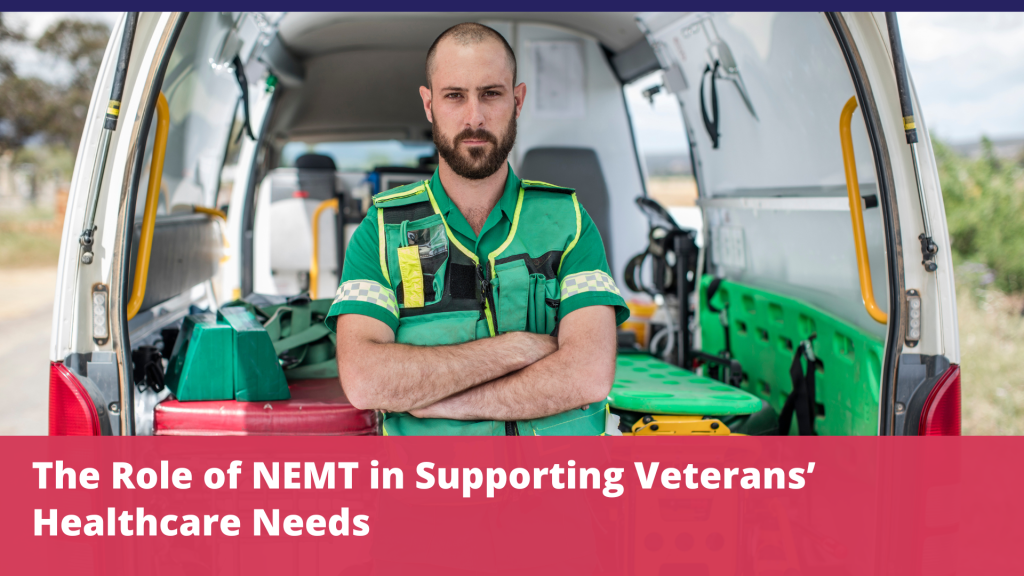New at Safr Care
The Role of NEMT in Supporting Veterans’ Healthcare Needs

Introduction
Veterans have made significant sacrifices in service to their country. But after their military service ends, many face a different kind of challenge—accessing reliable healthcare. While the United States has made progress in building healthcare infrastructure for veterans, one major barrier remains: transportation. Specifically, Non-Emergency Medical Transportation (NEMT) plays a critical, yet underappreciated, role in ensuring veterans get the consistent care they need. For many veterans—particularly those who are elderly, disabled, or living in rural areas—reliable NEMT can be the difference between ongoing health management and deteriorating conditions. This article explores the landscape of NEMT services for veterans, the challenges they face, and the strategies that can improve transportation access and overall health outcomes for this deserving population.
Understanding the Healthcare Needs of Veterans
Veterans are a diverse group, encompassing men and women of various ages, ethnic backgrounds, and service experiences. As a result, they face a wide range of medical issues:
– Chronic illnesses such as diabetes, hypertension, and COPD
– Mental health disorders, including PTSD, depression, and substance abuse
– Service-related disabilities, such as amputations, spinal injuries, and mobility impairments
– Geriatric care needs, as the population of aging veterans continues to grow
– Mental health disorders, including PTSD, depression, and substance abuse
– Service-related disabilities, such as amputations, spinal injuries, and mobility impairments
– Geriatric care needs, as the population of aging veterans continues to grow
These conditions often require regular medical appointments, therapy sessions, rehabilitation, lab work, and follow-up visits. Without reliable transportation, veterans may be forced to skip care altogether.
What is Non-Emergency Medical Transportation (NEMT)?
NEMT refers to pre-scheduled transport for patients who need to access medical services but don’t require emergency assistance. These services can include: Ambulatory transport (standard vehicles), Wheelchair-accessible vans, Stretcher transport, Specialized services with trained attendants. While many people think of ambulances for urgent care, NEMT ensures access to routine and preventive care—a crucial factor for veterans managing chronic or complex health conditions.
Why NEMT Is Critical for Veterans
1. Bridging the Rural Access Gap
Over 4.7 million veterans live in rural America, often far from Veterans Affairs (VA) hospitals or clinics. In these areas, public transportation is limited or non-existent. NEMT services are essential for: Reaching VA Medical Centers that may be hours away, Attending specialized appointments in urban facilities, Accessing community-based outpatient clinics. Without NEMT, these veterans are effectively isolated from care.
2. Supporting Disabled and Elderly Veterans
Mobility issues are common among veterans due to age, injury, or disability. Wheelchair-accessible and stretcher NEMT vehicles provide the infrastructure needed to safely transport individuals who might otherwise struggle to leave their homes.
3. Reducing Missed Appointments
When veterans miss appointments due to transport issues, it disrupts treatment plans, delays diagnosis, and leads to worsening health outcomes. Missed care also increases long-term costs for the VA and taxpayers.
4. Enhancing Mental Health Access
Mental health appointments, including therapy, group sessions, and psychiatric consultations, are often missed due to anxiety, depression, or lack of transportation. A dedicated, comfortable, and timely NEMT service can encourage veterans to seek the help they need.
The Department of Veterans Affairs and Transportation Programs
The VA offers several programs to facilitate medical transportation for veterans:
VA Travel Reimbursement Program
The VA offers travel reimbursement for eligible veterans, helping cover mileage or public transit costs to approved medical appointments. However, not all veterans qualify, and many are unaware of the program or find the reimbursement process complicated.
Veterans Transportation Service (VTS)
The VTS was established to provide direct transport for eligible veterans using VA-owned vehicles. It serves as a critical NEMT solution but is: Not available in all regions, Often limited by fleet size and scheduling capacity, Sometimes plagued by coordination inefficiencies.
VA Partnerships with Community Providers
To expand reach, the VA increasingly partners with third-party NEMT providers. This allows for greater geographic coverage and access to specialized transport but introduces logistical and billing challenges.
Barriers Veterans Face in Accessing NEMT
– Awareness and Outreach
– Bureaucratic Hurdles
– Lack of Family or Community Support
– Cultural and Psychological Barriers
– Bureaucratic Hurdles
– Lack of Family or Community Support
– Cultural and Psychological Barriers
Technology’s Role in Expanding NEMT for Veterans
Digital scheduling platforms, AI and predictive routing, Telehealth and NEMT integration, and Data sharing with the VA are transforming NEMT efficiency and patient experience.
Community-Based Innovations
Volunteer driver programs, Ride-share partnerships, and State-funded pilot programs offer low-cost and scalable solutions to veteran transportation gaps.
Best Practices for NEMT Providers Serving Veterans
Cultural competency training, flexible scheduling, diverse transport modalities, and veteran feedback loops are key to delivering dignified care experiences.
The Future of Veteran-Focused NEMT
Future systems should be integrated, scalable, veteran-centric, and tech-driven—ensuring all veterans receive timely, respectful, and consistent healthcare access.
Conclusion
Veterans deserve more than gratitude—they deserve accessible, high-quality healthcare. Non-Emergency Medical Transportation plays a pivotal role in ensuring they receive it. By removing transportation as a barrier to care, we can improve veterans’ health outcomes, reduce systemic costs, and honor the promise made to those who served. The road to recovery shouldn’t be out of reach. Through thoughtful policy, technological innovation, and community collaboration, NEMT can help every veteran get the care they’ve earned—on time, every time.
